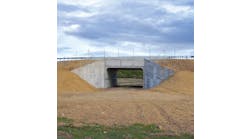By: Brian W. Budzynski
This year’s selection for the top bridge project in North America is a multi-faceted, dynamic structure that faced more than its fair share of challenges, in both design and construction, and had the added burden of being not only a crucial thoroughfare to the city of Montreal but a replacement for a historic structure that contributes significantly to the Canadian economy.
The New Champlain Bridge spans the St. Lawrence River between Île des Soeurs and the South Shore in Montreal; this 3.4-km structure is the keystone of a larger, 8.4-km corridor reconstruction project, which also includes adjacent highway reconstruction and widening of the federal portion of Autoroute 15 and a new Île des Soeurs bridge. The new bridge is comprised of three independent superstructures supported by common piers—a 2,044-meter west approach, a 762-meter east approach and the 529-meter cable-stayed bridge itself.
The asymmetric, cable-stayed bridge features a 155-meter-high concrete tower and stay cables in a harp arrangement, an aesthetic element that designers felt would bolster the bridge’s place amongst the architecture of the cityscape. The three-corridor design of the project includes two three-lane roadways for vehicular traffic, a multi-use path for pedestrians and cyclists as well as a two-lane transit artery that will accomodate a light-rail system.
The Government of Canada selected Signature on the Saint Lawrence Construction (a partnership of SNC-Lavalin Major Project Inc., Dragados Canada Inc., Flatiron Constructors Canada Ltd. and EBC Inc.) and TYLI-IBT-SLI Joint Venture (a design joint venture of managing partner T.Y. Lin International Canada Inc., International Bridge Technologies Canada Inc. and SNC-Lavalin Inc.) to design and build the new bridge through a P3 procurement process.
No easy feat
River work is a persistent and ever-evolving challenge—ask any engineer who has designed or built in a marine environment—and this project was no exception. Given the site’s harsh climates, local geologic conditions, and seismicity, the design team undertook specialized studies on wind, seismicity, scour potential, vessel collision, and ice loading, among others, to provide the basis for the design criteria.
“The design ice thickness in the St. Lawrence River at the location of the bridge is about 35.4 in.,” Guy Mailhot, chief engineer for bridge owner Infrastructure Canada, told Roads & Bridges. “The piers under construction also had to resist potentially significant ice forces during construction where piers were partially built (individual pier stems and/or pier legs without the upper pier caps which connect the two legs). Furthermore, the properties of the concrete used for the piers in the ice abrasion zone had to be specially developed to resist abrasion due to ice effects.”
Considerations for ice accretion and ice shedding on the bridge stays was an important factor in the design of the bridge. The design-builder developed customized cable sheathing that underwent specialized numerical modeling and testing at the National Research Council of Canada and Force laboratory in Denmark.
“While wind tunnel studies of a stay-cable exposed to dry-wind conditions and rain-wind conditions are common practice,” noted Mailhot, “the aerodynamic study of a stay-cable under ice-wind conditions represents a relatively new field of research.”
Due to the high number of freeze-thaw cycles, the extensive use of salts in the Montreal area and the 125-year imposed design life for all non-replaceable components, which includes the deck slab, the owner imposed the use of stainless rebar in 100% of the deck slab, eschewing initial cost savings for longer-term sustainability.
The overall construction timeline was a tight 42 months, which made for an accelerated schedule. Consequently, precast elements played a major role in project planning and execution. For exmaple, crews were able to erect all 44 segments of the lower tower legs of the main span tower in 36 days using precast elements.
“Off-site prefabrication took some pressure off the on-site construction teams,” said Marwan Nader of engineer-of-record T.Y. Lin International, so that crews could focus more directly on other construction components. Heavy gravity-based footing and pier starters for in-water approach spans with units weighing 800 to 900 metric tonnes were prefabricated on-site at a temporary CSA-certified precasting plant installed on an adjacent jetty. The units were then delivered to their final location using a custom-built gantry mounted on a large catamaran barge. This strategy was key to meeting the delivery schedule. Precast concrete segments for the approach piers and the main-span tower were fabricated in a CSA-certified precast plant 100 km from the construction site, and delivered by way of a combination of road, rail and ship/barge. Also, the 9,638 precast deck slabs were prefabricated off-site locally and delivered to the site for installation. “Currently, 440 panels can be installed on the bridge in a single week,” Nader said.
Although the St. Lawrence River is very wide, the water depth in certain areas is not very deep, particularly in the summer months. Lifting of heavy prefabricated segments (pier segments, steel pier caps and preassembled steel girders) by cranes mounted on barges required large barges due to the low draft. In certain locations, marine excavation of the river bed was required to move the barges into position. In-water works also needed to be carried out during winter months where issues of extremely cold water and ice movement along the river had to be properly addressed to assure safety for workers at all times.
A further challenge was that the new bridge was being built while the existing bridge itself had to undergo extensive work to keep it safely in service until traffic could be redirected to the new infrastructure. “This resulted in a need for close cooperation between authorities, neighboring contractors and construction teams,” Chantale Coté, project director for Infrastructure Canada, told Roads & Bridges, “considering that the new bridge essentially touches the existing bridge at its landing at the east and west abutments.” Traffic was maintained on the existing bridge at its approaches, which required complicated traffic management and added to the challenges that had to be faced. Moreover, a 109-meter-long clear span had to be constructed over a major freeway, which required careful planning and coordination.
This project was the first large-scale bridge project in Canada to receive a Platinum Envision award from the Institute for Sustainable Infrastructure.
Project: New Champlain Bridge
Location: Montreal, Quebec, Canada
Owner: Infrastructure Canada
Designer: TYLI-IBT-SLI (joint venture)
Contractor: Signature on the Saint Lawrence Construction (joint venture)
Cost: $2.4 billion
Length: 3.4 km
Completion Date: June 2019
About The Author: Budzynski is managing editor of Roads & Bridges.



